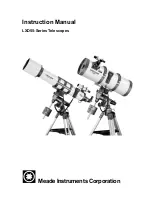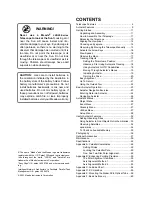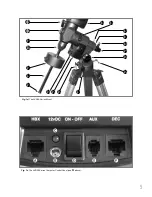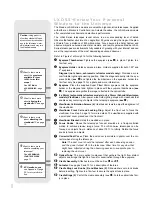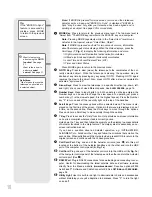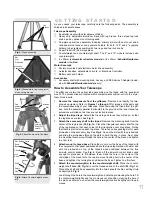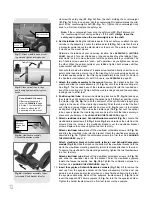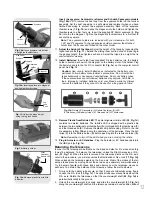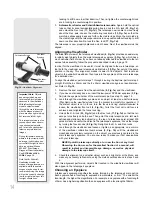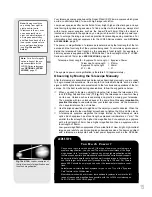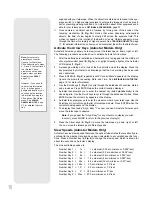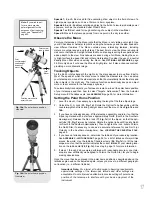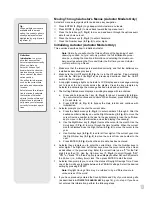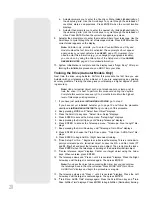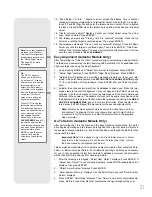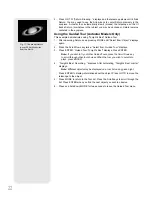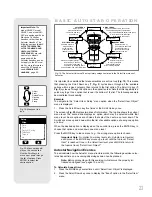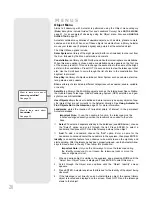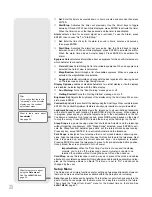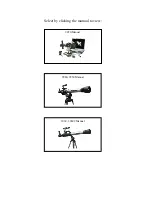
14
Important Note: Objects
appear upside-down and
reversed left-for-right when
observed in the viewfinder.
With refracting telescope
models, objects viewed
through the main telescope
with the diagonal mirror in
place are seen right-side-up,
but reversed left-for-right.
This image inversion is of no
consequence when observ-
ing astronomical objects,
and in fact all astronomical
telescopes yield inverted
images.
During terrestrial observing,
where a fully-correctly-orient-
ed image (right-side up and
correct left-for-right) is desir-
able, an optional Meade
#928 45° Erect-Image
Diagonal Prism is available.
See
OPTIONAL ACCES-
SORIES
, page 38.
Note that for Schmidt-
Newtonian models, no
means of image inversion is
available; while these tele-
scopes may be used for ter-
restrial observing, the image
will not be correctly oriented
in either right-side-up or left-
for-right orientations.
tending to drift down in either direction. Then re-tighten the counterweight lock
knob, locking the counterweight in position.
3.
Achromatic refractor and Schmidt-Newtonian models: Again, hold the optical
tube so that it cannot accidentally swing freely. Lock the R.A. lock (33, Fig. 1d),
and unlock the Dec. lock (17, Fig. 1d). The telescope now is able to move freely
about the Dec. axis. Loosen the cradle ring lock knobs (13, Fig. 1a) so that the
main tube slides easily back and forth in the cradle rings. Move the main tube in
the cradle rings until the telescope remains in one position without tending to drift
down in either direction. Re-lock the Dec. lock (17, Fig. 1d).
The telescope is now properly balanced on both axes. Next, the viewfinder must be
aligned.
Aligning the Viewfinder
The wide field of view of the telescope's viewfinder (4, Fig. 1a) provides an easier way
to initially sight objects than the main telescope's eyepiece (3, Fig. 1a), which has a
much narrower field of view. If you have not already attached the viewfinder to the tel-
escope tube assembly, follow the procedure described in step 9, page 12.
In order for the viewfinder to be useful, it must be aligned to the main telescope, so
that both the viewfinder and telescope's optical tube (10, Fig. 1a) point at the same
position in the sky. This alignment makes it easier to find objects: First locate an
object in the wide-field viewfinder, then look into the eyepiece of the main telescope
for a detailed view.
To align the viewfinder, perform steps 1 through 4 during the daytime; perform step 5
at night. Both the 6 x 30mm and the 8 x 50mm viewfinders align in an identical man-
ner. Refer to Fig. 14.
1.
Remove the dust covers from the optical tube (9, Fig. 1a) and the viewfinder.
2.
If you have not already done so, insert the low-power SP 26mm eyepiece (3, Fig.
1b) into the eyepiece holder of the main telescope. See step 10, page 12.
3.
Look through the viewfinder eyepiece at an object at least one-half mile away
(Tip: Remove the viewfinder tube from the bracket to simplify this operation). If
the distant object is not in focus, turn the focus lock ring counterclockwise to
loosen the viewfinder front cell (6, Fig. 1b). Twist the front cell until focus is
achieved and retighten the focus lock ring.
4.
Unlock the R.A. lock (33, Fig. 1d) and the Dec lock (17, Fig. 1d) so that the tel-
escope turns freely on both axes. Then point the main telescope at a tall, well-
defined and stationary land object (e.g., the top of a telephone pole) at least 200
yards distant and center the object in the telescope's eyepiece. Focus the image
by turning the focus knobs (8, Fig. 1b). Retighten the R.A. and Dec. locks.
5.
Look through the viewfinder and loosen or tighten, as appropriate, one or more
of the viewfinder collimation thumbscrews (5, Fig. 1b) until the viewfinder’s
crosshairs are precisely centered on the object you previously centered in the
main telescope's eyepiece. You are now ready to make your first observations
with your telescope.
NEVER point the telescope directly at or near the Sun at any time!
Observing the Sun, even for the smallest fraction of a second, will
result in instant and irreversible eye damage, as well as physical
damage to the telescope itself.
5.
Check this alignment on a celestial object, such as a bright star or the Moon, and
make any necessary refinements, using the method outlined above in steps 3 and
4.
With this alignment performed, objects first located in the wide-field viewfinder will
also appear in the telescope's eyepiece.
Choosing an Eyepiece
A telescope’s eyepiece magnifies the image formed by the telescope’s main optics.
Each eyepiece has a focal length, expressed in millimeters, or “mm.” The smaller the
focal length, the higher the magnification. For example, an eyepiece with a focal length
of 9mm has a higher magnification than an eyepiece with a focal length of 26mm.
Collimation Screws
Viewfinder
Eyepiece
Fig. 14: Viewfinder Alignment.
Viewfinder
Bracket
Summary of Contents for LXD55 Series
Page 1: ...Meade Instruments Corporation Instruction Manual LXD55 Series Telescopes...
Page 2: ......
Page 63: ......

